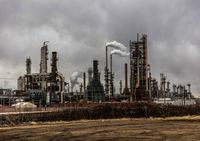INDUSTRIAL PROCESS MONITORING
Monitoring greenhouse gases, volatile organic compounds (VOC's) or specialty gases, like hydrogen peroxide or hydrogen fluoride, are often required to identify gas sources, ensure safety, or confirm compliance in industrial environments. Depending on industry and research, rules or regulations may dictate concentration limits or handling practices for compounds such as ammonia, hydrogen chloride, hydrogen fluoride or VOC's.
Also, measuring gases at trace concentration levels is to ensure high process yields or consistent process quality and results.
Petrochemical
During drilling or fracking, carbon isotopes can be measured to determine the presence/location of thermogenic gas. Thermogenic gas (including shale gas and coalbed methane) is discriminated from biogenic gas due to differences in d13C in methane and the presence of ethane.
Measuring (fugitive) emissions at a drilling, fracking or CO2 sequestration site, becomes more and more of a requirement for regulation and safety purposes. Additionally, measuring isotopes provides more information on the water quality of nearby ground water and drinking water wells.
Automotive
Air pollution has been attributed to automobile exhaust as the major source. Combustion engines used in cars, aircraft, ships, power plants, etc. emit many air pollutants that have been shown to have a variety of negative effects on public health and the natural environment. Emission testing of combustion engines has therefore been the focus of intense studies. Apart from the emissions comprising carbon monoxide (CO), nitrogen oxides (NOx), particulate matter, and sulfur oxides (SOx), also volatile organic compounds (VOC's) and their atmospheric photochemical reaction products have lately drawn much attention due to their negative impact on the atmosphere and their dangers to public health.
